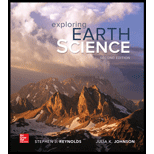
The difference among the four families of rocks along with formation of each.
Answer to Problem 1BYL
Sedimentary rocks are formed by the consolidation of the deposited sediments or even by the precipitation of minerals from water and extraction of materials from water by corals and other organisms. The cooling and solidification of magma either at depth or after being vented onto the surface lead to the formation of igneous rocks. When the preexisting sedimentary or igneous rocks get metamorphosed under high temperature or pressure or both, metamorphic rocks are developed. The rocks that develop by precipitation from hot water are defined as hydrothermal rocks.
Explanation of Solution
There are principally four families of rocks, which comprises sedimentary rocks, igneous rocks, metamorphic rocks, and hydrothermal rocks. All the rocks have their own process of formation.
The loose sediments deposited on the surface of the Earth by moving air, water, or ice form the source materials of sedimentary rocks. When these sediments get buried, compacted, cemented, and lithified, they get transformed into hard sedimentary rocks over time. The development of other types of sedimentary rocks are through the precipitation of minerals from water or through coral and other organisms, which extract materials directly from water.
Igneous rocks are the ones that are formed by the sooling and solidification of magma. These rocks form when ash and lava are erupted out of the volcanoes or when cystallization of molten rock takes place in the magma chambers at depth.
The rocks that are altered and deformed by temperatures, pressures, or both are termed as the metamorphic rocks. Metamorphism can bring modifications in the sedimentary rocks, igneous rocks, or even in already existing metamorphic rocks. Lastly, the rocks that directly get precipitated from hot water are known as hydrothermal rocks. Certain geoscientists have classified such rocks into the metamorphic rock category.
Want to see more full solutions like this?
Chapter 3 Solutions
Exploring Earth Science
 Applications and Investigations in Earth Science ...Earth ScienceISBN:9780134746241Author:Edward J. Tarbuck, Frederick K. Lutgens, Dennis G. TasaPublisher:PEARSON
Applications and Investigations in Earth Science ...Earth ScienceISBN:9780134746241Author:Edward J. Tarbuck, Frederick K. Lutgens, Dennis G. TasaPublisher:PEARSON Exercises for Weather & Climate (9th Edition)Earth ScienceISBN:9780134041360Author:Greg CarbonePublisher:PEARSON
Exercises for Weather & Climate (9th Edition)Earth ScienceISBN:9780134041360Author:Greg CarbonePublisher:PEARSON Environmental ScienceEarth ScienceISBN:9781260153125Author:William P Cunningham Prof., Mary Ann Cunningham ProfessorPublisher:McGraw-Hill Education
Environmental ScienceEarth ScienceISBN:9781260153125Author:William P Cunningham Prof., Mary Ann Cunningham ProfessorPublisher:McGraw-Hill Education Earth Science (15th Edition)Earth ScienceISBN:9780134543536Author:Edward J. Tarbuck, Frederick K. Lutgens, Dennis G. TasaPublisher:PEARSON
Earth Science (15th Edition)Earth ScienceISBN:9780134543536Author:Edward J. Tarbuck, Frederick K. Lutgens, Dennis G. TasaPublisher:PEARSON Environmental Science (MindTap Course List)Earth ScienceISBN:9781337569613Author:G. Tyler Miller, Scott SpoolmanPublisher:Cengage Learning
Environmental Science (MindTap Course List)Earth ScienceISBN:9781337569613Author:G. Tyler Miller, Scott SpoolmanPublisher:Cengage Learning Physical GeologyEarth ScienceISBN:9781259916823Author:Plummer, Charles C., CARLSON, Diane H., Hammersley, LisaPublisher:Mcgraw-hill Education,
Physical GeologyEarth ScienceISBN:9781259916823Author:Plummer, Charles C., CARLSON, Diane H., Hammersley, LisaPublisher:Mcgraw-hill Education,





